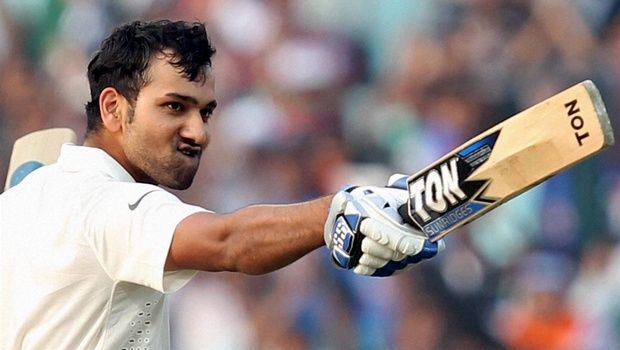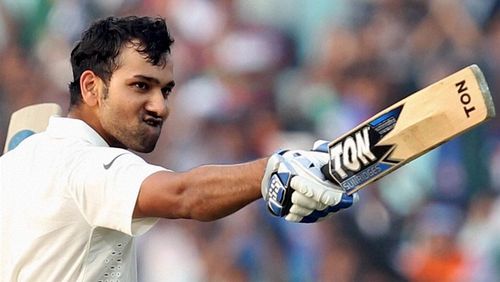
Playing devil's advocate for Rohit Sharma: Give talent the stage to showcase itself

Of late, Rohit Sharma has come in for heavy criticism as a result of his overseas failures, and it is completely understandable. But the calls to drop him from the ODI team and incorporate Murali Vijay instead are not just surprising, but farcical and double-faced.
There is a reason why we don’t do too well in theoretical exams: our memory betrays us quite alarmingly. It wasn’t too long ago that there were calls for dropping Vijay from the side and open with KL Rahul, instead. It wasn’t too long ago that Rohit played an innings that will likely never be bettered by any player. It wasn’t too long ago that Facebook and Twitter were abuzz in awe of his ‘talent’.
One and a half Test matches later, Vijay is the apple of all eyes and Rohit is back to being a ‘flat track bully’. Flat track bully? Is every track in India as flat as an airport? Let us start with Eden Gardens, the place where Rohit amassed 264. How flat is Eden Gardens?
Nature of the Eden Gardens pitch
Eden Gardens is so flat that the 300-run mark has been crossed as many as seven times in 28 matches. Out of these seven times, thrice it was against world beaters Ireland, Netherlands and Kenya. Eden Gardens is so flat that India have gone for over 300 on this ground only once.
Eden Gardens is so flat that nine times have teams got all out or played 50 overs and yet scored below 200. In four further innings, teams have lost more than five wickets chasing below 200. The Indians, also termed as flat track bullies, have been bundled below 200 thrice. In comparison, they have scored above 300 only twice. Flat track, indeed.
A look at the history of the ground shows that in the 80s the average score here was 34.36 a wicket, 27.55 in the 90s and a whopping 41.06 in the 2000s. After 2010, it is as low as 29.98 at an economy of below 6. Among the six matches played here, Ireland and Netherlands have scored over 300 against each other and Zimbabwe amassed another 300+ score against Kenya. Leave those out and the average drops to 27.57 in four matches. In the three matches apart from Rohit’s bewildering innings, the average drops even further to 23.18 at 4.77.
Not to mention that in all the three matches, the team winning the toss thought it would be a great place to bat on and promptly bowled first. They lost all three, and the second innings average dipped to as low as 16.06. Flat track, indeed.
It would be more prudent to say that Rohit scores more at home than abroad than using the term flat track bully with no knowledge of Indian pitches. Now that we have established that he is not a flat track bully, let us move on further.
Is Rohit woeful in overseas ODIs?
It might come as a surprise that Rohit has played almost a hundred matches abroad and only 28 at home. That is it – 28 out of 126. From 1 January 2013, his second homecoming, he has played 27 matches away from home and 13 at home. He has eight scores in excess of 50 away from home and averages close to 37. 37 is what Yuvraj averaged in his entire career, both home and abroad combined.
Since 2013, Rohit has played six matches in England, five in New Zealand, two innings in South Africa and five in the West Indies. That’s just about it. He averages 38.16, 29, 18.50 and 54.25 in those countries respectively. If you think you can write him off in such a short sample space, I am not sure what to make of it.
The sample spaces are, indeed, too miniscule. The probable reason for the same is that the 2011 50-over World Cup, the 2012 and 2014 T20 World Cups were all held in the sub-continent, a fact quite conveniently ignored by his detractors. He has not played a single ODI in Australia during this period, and yet he is written off with some panache. And he averages over 85 in this period at home, on ‘flat tracks’ like Eden Gardens.
Is Rohit consistent?
This just has to be my personal favorite. What if a player averages 52.17 in the last two years? He’s inconsistent, of course. What if the player has the record for the highest aggregate in a bilateral series? He’s very inconsistent, of course. And what if a player scores a half-century once in every 2.78 innings? He is the epitome of inconsistency.
Let us delve deeper based into the innings-to-half-century ratio. Among the top run-getters in the world, Kumar Sangakkara rules the roost with a ratio of 2.13; Virat Kohli, India’s Mr. Consistent, has a ratio of 2.50; Tillakaratne Dilshan has 2.77; AB de Villiers 2.33; Shikhar Dhawan 2.69; Angelo Mathews 3.71 (2.71 subtracting not-outs); Hashim Amla 3.07; MS Dhoni 2.73; Misbah-ul-Haq has 2.58; George Bailey has 2.84 and Kane Williamson has 2.18.
From January 1, 2013 to the present, no other player with over 1,100 runs has a ratio better than 3.00. Barring Sangakkara, de Villiers and Williamson, Rohit’s ratio is favourably comparable to the rest. But, yes, he is inconsistent.
A 50+ score every three innings is not inconsistent by any stretch of the imagination. As for his strike rate overseas, given some time, it will come. The pitches in England, New Zealand and South Africa are not very easy to bat on. Once Rohit gets a hang of things, the strike rate will not be too far behind. There is no doubting what he’s capable of.
Just a point of note – if a player has played 86% of his matches away from home and still averages very close to 38 and strikes them at 81, he can’t be a bad player. This, to be noted, is his overall record right since his debut in 2007.
When Virender Sehwag or Yuvraj win you one out of three matches, they are match winners. When Rohit does so, he is inconsistent. Anyway, to dwell on player versus player will not do justice to Rohit.
Is Rohit fit for Test cricket?
People who have never played the game at the highest level cannot understand what it is like to play Test cricket for your country. Among those who have, no one understands the value of Test Cricket as much as Rohit. Rohit made his Test debut after having played more than a hundred ODIs, the highest by any player in the history of the game, despite having an average of over 60 in first-class cricket.
This, by the way, is a proof that he made the ranks on the basis of stellar performances and not ‘talent’. One might say that he has kept his spot at times solely due to his potential, due to what he is capable of, but those who say that he made the team on the back of ‘talent’ have never really watched domestic cricket.
Rohit is only eight Tests old. How can a person’s career be judged in 14 innings?
How Rohit Sharma’s short Test career measures up to other greats
Let us put this in perspective. X is having a great domestic season. X is playing brilliantly in tour games. X is knocking the selection doors loudly.
Rohit plays eight Tests and gets dropped. X comes in. X plays eight Tests; X cannot adjust to the rigours of international cricket so soon and gets dropped. Rohit, meanwhile, goes back to domestic cricket, plunders runs the way he used to and gets back in place of X. Repeat the process forever.
Has chopping and changing ever really helped? Ask Australia. Mickey Arthur tried this technique and found absolutely no success. Darren Lehmann comes in, provides his bunch security and gives them assurance. The Aussies bounce back like a spring. When you back a player, you have to back him to the hilt. Bear in mind, Rohit is vying for a permanent spot, not coming in as a replacement for an injured player.
Examples, facts and figures always help. After eight Tests, the legendary Sachin Tendulkar averaged 30.75 (he played all matches abroad, though), Ricky Ponting averaged 39.30 (5 games at home). Rahul Dravid averaged 34.61 (four each at home and abroad). Dravid had scores of 7, 27*, 2 and 12 in his first four innings in South Africa, 0 and 28 in New Zealand, 95 and 84 in England and 9 and 14 Down Under. In slight contrast, Rohit averaged 44.83 having played a single Test at home. Should all of these have been dropped then and there?
The list is not exhaustive; in fact, it is far from it. Test cricket is a game of virtue and patience, on and off the field. Experience is the key that unlocks potential. The argument that he gets out cheaply can be negated by experience. Once he becomes more experienced, he will not ‘throw it away’.
Rohit has a technique close to iron-clad. He has every single ingredient to succeed in Test cricket. His wicket has hardly ever been ‘taken’; he almost always throws it away. People are quick to notice he does throw them away, but the jaffas and peaches that he plays nonchalantly are selectively ignored by the same set. A person with this trait is more likely to succeed rather than someone who does not possess such class but is sterner in the mind.
Rohit does not have a weakness on the field. He has one in his head. He turned it around in ODIs. He almost certainly will do the same in the longest format. All he needs to do is contact master Yoda and get his brain to think straight. And that, on any given day, is easier than ironing out a technical a chink in your armour.